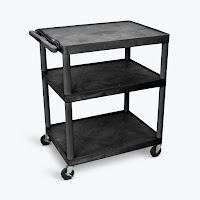Guide to Buying Wall Mount Network Cabinets
Have routers, patch panels, switches, and other networking items? Be sure to organize them and keep them off the floor with a handy piece of server furniture: a wall mount cabinet.
Wall mount network cabinets offer a space-saving solution to storing server equipment and networking items. As their name suggests, these server storage solutions can be mounted on the wall, letting you secure and keep your equipment nice and tidy.
But how do you know you’re getting the right one? Here are the things you need to consider before you buy a wall mount network cabinet online or elsewhere.
There is, however, one drawback to open frame wall mount racks: security. If you’re installing expensive network equipment in a public area, then you’re better off with a wall mount server cabinet.
This kind of server cabinet usually comes with a locking door that can be opened with a key, preventing unauthorized access and tampering. There are even some wall mount cabinets that feature reversible doors, which can be installed facing either to the right or to the left.
While open frame wall mount racks ensure better ventilation, high-quality wall mount cabinets do feature ventilation slots. Some even come with laser knockouts, which not only let you organize cables but also allow you to install optional fans for easy temperature control.
To help you make an informed purchasing decision, here are some of the most popular pieces of networking items as well as their rack units:
But if you have to access the back of your equipment often, then you have to get a swing-out wall mount network cabinet. Simply swivel it out, and you can easily access the rear of your network equipment.
Wall mount network cabinets offer a space-saving solution to storing server equipment and networking items. As their name suggests, these server storage solutions can be mounted on the wall, letting you secure and keep your equipment nice and tidy.
But how do you know you’re getting the right one? Here are the things you need to consider before you buy a wall mount network cabinet online or elsewhere.
Wall Mount Cabinets vs Open Frame Wall Mount Racks
One of the most common choices of wall mount server racks among IT professionals is an open frame wall mount rack. Because of its open frame design, this network rack allows for optimal ventilation, keeping network equipment from overheating.There is, however, one drawback to open frame wall mount racks: security. If you’re installing expensive network equipment in a public area, then you’re better off with a wall mount server cabinet.
This kind of server cabinet usually comes with a locking door that can be opened with a key, preventing unauthorized access and tampering. There are even some wall mount cabinets that feature reversible doors, which can be installed facing either to the right or to the left.
While open frame wall mount racks ensure better ventilation, high-quality wall mount cabinets do feature ventilation slots. Some even come with laser knockouts, which not only let you organize cables but also allow you to install optional fans for easy temperature control.
Rack Units
Another thing to consider is the size of your rackmount equipment. Wall mount cabinets, among most kinds of server furniture, are measured by rack units, or simply known as U. Each rack unit is 1.75 inches, and wall mount cabinets typically come in various rack units: 3U, 6U, 8U, 9U, 12U, 15U, 18U, and 22U—the most common ones being 8U, 15U, and 22U.To help you make an informed purchasing decision, here are some of the most popular pieces of networking items as well as their rack units:
- UPS: 1U to 2U
- NAS: 1U to 2U
- PDU: 1U to 2U
- Network Switch: 1U to 2U
- Patch Panels: 1U to 4U
- Servers: 1U to 4U
- Blade Servers: 5U to 10U
Fixed or Swing-Out?
Most wall mount network rack cabinets come in two styles: fixed and swing-out. Fixed wall mount network cabinets are exactly what they sound like—they remain stationary once they’re installed, making them a cheaper alternative to swing-out cabinets.But if you have to access the back of your equipment often, then you have to get a swing-out wall mount network cabinet. Simply swivel it out, and you can easily access the rear of your network equipment.

Comments
Post a Comment